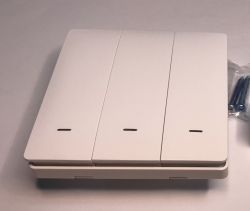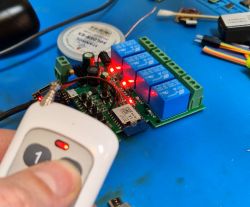I am running the lighting in the adapted loft and, having had experience with lighting control on the ground floor mainly based on Shelly, I wanted to do it differently upstairs:
1. The actuators will be isolated relays. The relays will be controlled by an ESP with ESPHome preloaded, so they should operate independently of the locally operating Home Assistant.
2. I have the switches brought in star to the switchgear and they need to be fed into the inputs of these ESPs. I assume that ESPHome has this functionality. I can run 3.3V to the switch, pull up to ground with a resistor, or to 3.3V - I'll figure it out. I'm just wondering if I shouldn't use, for example, 12 or 24V on the switches and use a divider before the ESP to bring the whole thing down to an appropriate level of 0/3.3V. It seems that a higher voltage would be more resistant to any interference that might occur from the 230V mains, as many wires run in parallel to light sources/sockets/switches. I know there are software methods for de-bounce that should eliminate this, but if 12 or 24V would help something, why not. I'll definitely have 12V in the installation or 12 and 24V from the gym to supply central power to a couple of WiFi routers so the presence of 12 or 24V in the switchgear is no problem.
All cables I have are for 230V + some additional ones typically for alarms still as additional to the points where the switches are.
What voltage are you running to the "light switches" assuming the actuator will be an ESP8266/ESP32 controller?
1. The actuators will be isolated relays. The relays will be controlled by an ESP with ESPHome preloaded, so they should operate independently of the locally operating Home Assistant.
2. I have the switches brought in star to the switchgear and they need to be fed into the inputs of these ESPs. I assume that ESPHome has this functionality. I can run 3.3V to the switch, pull up to ground with a resistor, or to 3.3V - I'll figure it out. I'm just wondering if I shouldn't use, for example, 12 or 24V on the switches and use a divider before the ESP to bring the whole thing down to an appropriate level of 0/3.3V. It seems that a higher voltage would be more resistant to any interference that might occur from the 230V mains, as many wires run in parallel to light sources/sockets/switches. I know there are software methods for de-bounce that should eliminate this, but if 12 or 24V would help something, why not. I'll definitely have 12V in the installation or 12 and 24V from the gym to supply central power to a couple of WiFi routers so the presence of 12 or 24V in the switchgear is no problem.
All cables I have are for 230V + some additional ones typically for alarms still as additional to the points where the switches are.
What voltage are you running to the "light switches" assuming the actuator will be an ESP8266/ESP32 controller?






